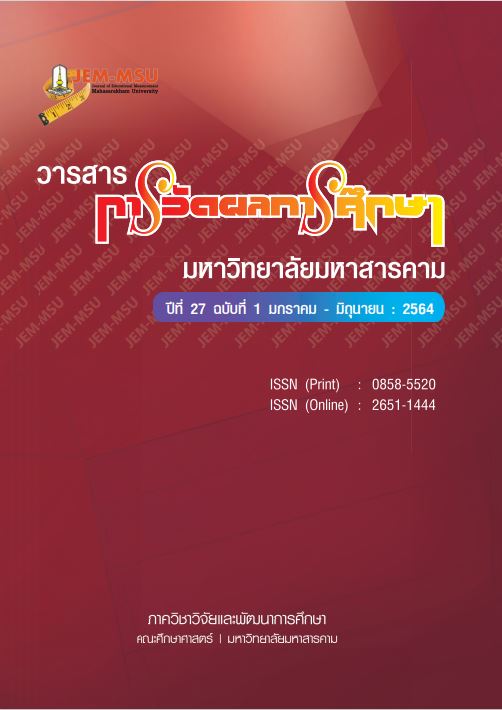Development of Tests for Electronic Item Bank for Tests Measuring Learning Outcomes of Students in Undergraduate Education Programs Based on the Thai Qualifications Framework for Higher Education: An Application of Multidimensional Item Response Theory
Main Article Content
Abstract
The purposes of this study were to 1) develop a measurement model of learning outcomes of students in undergraduate education programs based on the Thai Qualifications Framework for Higher Education, 2) develop tests for measuring learning outcomes of students in undergraduate education programs based on the Thai Qualifications Framework to be stored in the electronic item bank. The sample consisted of 1,014 fourth year undergraduate students, obtained through multi-stage sampling. The research instruments were tests for measuring learning outcomes of students in undergraduate education programs based on the Thai Qualifications Framework for Higher Education. Data analysis employed G2, AIC, BIC, difficulty parameter and discrimination parameter. The results were as follows:
1. There were 4 measurement models for measuring learning outcomes of students in undergraduate education programs based on the Thai Qualifications Framework for Higher Education: 1) the cognitive skill measurement model, 2) the interpersonal and responsibility skills measurement model, 3) the numerical analysis, communication, information technology skills measurement model, and 4) the learning management skill measurement model. The construct validity analysis of the measurement models showed that the measurement models had propriety.
2. The items for electronic item bank measuring learning outcomes of students in undergraduate education programs based on the Thai Qualifications Framework for Higher Education were 4-choice situational tests consisting of 279 items, with the IOC ranging from 0.60 to 1.00. In addition, the item analysis based on MIRT showed that the two-parameter multidimensional item response models were best fit for all test forms, with the mean of item difficulty parameter of 0.069 and the mean of item discrimination parameter of 0.862. As a whole, it can be concluded that the difficulty level of the tests was in the moderate level and had good discrimination.
Article Details
The content and information contained in the published article in the Journal of Educational Measurement Mahasarakham University represent the opinions and responsibilities of the authors directly. The editorial board of the journal is not necessarily in agreement with or responsible for any of the content.
The articles, data, content, images, etc. that have been published in the Journal of Educational Measurement Mahasarakham University are copyrighted by the journal. If any individual or organization wishes to reproduce or perform any actions involving the entirety or any part of the content, they must obtain written permission from the Journal of Educational Measurement Mahasarakham University.
References
กุญช์ภัสส์ พงษ์พานิชย์. (2561). การวิเคราะห์องค์ประกอบและตัวบ่งชี้สมรรถนะด้านการจัดการเรียนการสอนของครูผู้สอนนักเรียนระดับปฐมวัยที่ใช้ภาษาไทยเป็นภาษาที่สอง. วารสารมหาวิทยาลัยราชภัฏยะลา, 13(1), 1-12.
โชติกา ภาษีผล. (2561). รายงานผลการวิจัยเรื่องระบบการทดสอบแบบปรับเหมาะด้วยคอมพิวเตอร์สำหรับการวัดทักษะด้านเทคโนโลยีสารสนเทศและการสื่อสารแห่งศตวรรษที่ 21 ของนิสิตนักศึกษาปริญญาตรี. คณะครุศาสตร์ จุฬาลงกรณ์มหาวิทยาลัย, กรุงเทพฯ.
ดวงแก้ว เงินพูลทรัพย์ และคณะ. (2561). การพัฒนาแบบทดสอบทักษะการรู้สารสนเทศสำหรับนักศึกษาระดับปริญญาตรี สาขาวารสารศาสตร์. วารสารบรรณศาสตร์ มศว, 11(1), 176-190.
ตรีคม พรมบุญ. (2561). การพัฒนาแบบวัดคุณลักษณะครูยุคใหม่สำหรับนักศึกษาครุศาสตรบัณฑิต ชั้นปีที่ 4 มหาวิทยาลัยราชภัฏสุรินทร์: การประยุกต์ใช้การทำหน้าที่ต่างกันของข้อสอบ. วารสารการวัดผลการศึกษา มหาวิทยาลัยมหาสารคาม, 24(1), 138-151.
บัลลังก์ โรหิตเสถียร. (2559). นโยบายการผลิตครูในศตวรรษที่ 21. สืบค้นเมื่อ 2 ตุลาคม 2562, ได้จาก: https://www.รักครู.com/7097/.
เพชรรัตน์ สายนำพามีลาภ, อ้อมจิตร แป้นศรี และสำราญ มีแจ้ง. (2557). การวิเคราะห์องค์ประกอบคุณลักษณะของครูคุณภาพในยุคปฏิรูปการศึกษาตามการรับรู้ของครูในสังกัดสำนักงานเขตพื้นที่การศึกษามัธยมศึกษา เขต 39. สักทอง : วารสารมนุษยศาสตร์และสังคมศาสตร์, 20 (1), 61-72.
วิไลลักษณ์ ลังกา. (2560). อนาคตภาพของคุณลักษณะครูไทยในทศวรรษหน้า (พ.ศ.2560-2569). วารสารวิจัยทางการศึกษา คณะศึกษาศาสตร์ มหาวิทยาลัยศรีนครินทรวิโรฒ, 11 (1), 36-50.
ศิริชัย กาญจนวาสี. (2555). ทฤษฎีการทดสอบแนวใหม่ (พิมพ์ครั้งที่ 4). กรุงเทพฯ: โรงพิมพ์แห่งจุฬาลงกรณ์มหาวิทยาลัย.
ส. วาสนา ประวาลพฤกษ์. (2539). “การประเมินผลการเรียนให้สอดคล้องกับสภาพจริงโดยใช้แฟ้มสะสมงาน”, สารพัฒนาหลักสูตร, 15(126), 41-43.
สุเทพ ธรรมะตระกูล และอนุวัติ คูณแก้ว. (2555). การศึกษาคุณลักษณะของครูยุคใหม่. คณะครุศาสตร์ มหาวิทยาลัยราชภัฏเพชรบูรณ์.
สมชาย วรกิจเกษมสกุล. (2554). สถิติประยุกต์สำหรับการวิจัยทางพฤติกรรมศาสตร์และ สังคมศาสตร์. อุดรธานี: คณะครุศาสตร์ มหาวิทยาลัยราชภัฏอุดรธานี.
สำนักงานคณะกรรมการการอุดมศึกษา. (2552). กรอบมาตรฐานคุณวุฒิระดับอุดมศึกษาแห่งชาติ พ.ศ. 2552.
สำนักงานคณะกรรมการการอุดมศึกษา. (2556). แผนพัฒนาการศึกษาระดับอุดมศึกษา ฉบับที่ 11 (พ.ศ. 2555-2559). กรุงเทพฯ: โรงพิมพ์แห่งจุฬาลงกรณ์มหาวิทยาลัย.
สำนักงานคณะกรรมการการอุดมศึกษา. (2563). ดาวน์โหลดสถิติอุดมศึกษา นักศึกษารวม. สืบค้นเมื่อ 11 มีนาคม 2563, ได้จาก: http://www.info.mua.go.th/info/.
สำนักงานเลขาธิการสภาการศึกษา. (2553). กรอบคุณวุฒิแห่งชาติ (National Qualifications Framework) : กรณีศึกษากรอบคุณวุฒิทางการศึกษาของต่างประเทศ. กรุงเทพฯ: สกศ.
Anderson, L. W., & Krathwohl, D. R. (2001). A taxonomy for learning, teaching and assessing: A revision of Bloom’s Taxonomy. New York: Longman.
Baker. F. B., & Kim, S. H. (2017). The basics of item response theory using R. New York: Springer.
de la Torre, J. (2009). Improving the quality of ability estimates through multidimensional scoring and incorporation of ancillary variables. Applied Psychological Measurement, 33(6), 465-485.
de la Torre, J., & Patz, R. J. (2005). Making the most of what we have: A practical application of multidimensional item response theory in test scoring. Journal of Educational and Behavioral Statistics, 30(3), 295–311.
Downing, S. M., & Haladyna, T. M. (2006). Handbook of test development. MahWah, NJ: Lawrence Erlbaum Associates.
Embretson, S. E., & Reise, S. P. (2000). Item Response Theory for Psychologists. New Jersey: Lawrence Erlbaum Associates.
Wingersky, M. S., & Lord, F. M. (1984). An investigation of methods for reducing sampling error in certain IRT procedures. Retrieved October 2, 2018, from https://conservancy.umn.edu/bitstream/handle/11299/101951/1/v08n3p347.pdf.


